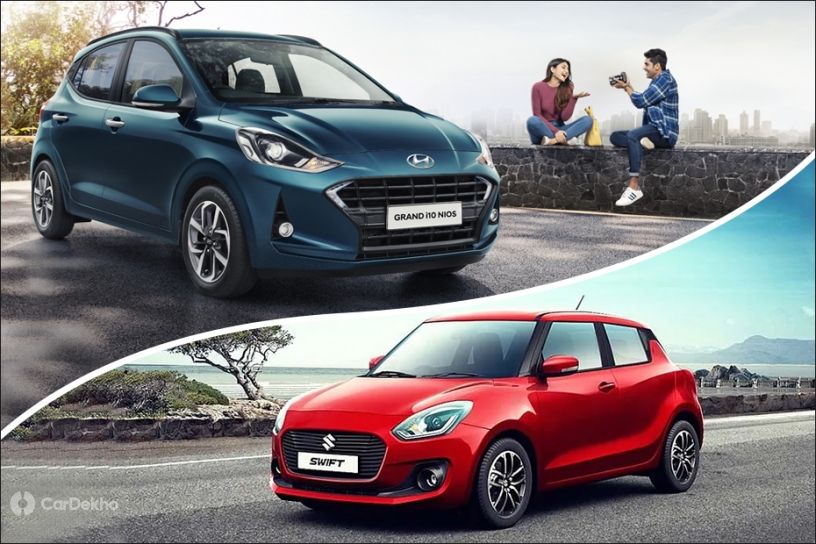Hyundai Grand i10 Nios vs Maruti Swift: In Pics
Published On Sep 01, 2019 04:00 PM By Sonny
- Write a comment
Can Hyundai’s latest hatchback iteration steal the Swift’s thunder?

The latest generation of the Hyundai mid-size hatchback has been launched in India as the Grand i10 Nios with prices ranging between Rs 5 lakh to Rs 7.99 lakh (ex-showroom Delhi). One of its main rivals is the Maruti Suzuki Swift which is priced from Rs 5.14 lakh to Rs 8.89 lakh (ex-showroom, Delhi).
Both are offered with BS6-compliant petrol engines alongside a BS4 diesel engine. And both engines are available with a manual transmission as well as an AMT option. If you want to see which one offers better value at similar prices, check out our variant-wise comparison here.
But here, we’re just going to see how the Grand i10 Nios and Swift compare in pictures:
Front


Even though the Nios has grown in size compared to its predecessor, the Swift is still bigger. Its extra width is visible in its stance but its front end design looks subtler than the Nios’.


The new Hyundai cascading grille features integrated boomerang-shaped DRLs while the front fog lamps are positioned with indents that look like air vents. Overall, it looks sportier than the single-piece grille design of the Swift.


Hyundai has fitted the Nios with projector headlamps but they’re still not LED units. Meanwhile, the top-spec Swift gets auto LED projector headlamps and the LED DRLs are integrated into the headlamp units.
Side


Both cars have the same wheelbase but the Swift is still 35mm longer than the Grand i10 Nios. In terms of design, the Nios looks sportier with its sloping roof, lower height and arching windowline as compared to the Swift’s boxy windows.


The Swift gets the quirky rear door handles mounted next to the C-pillar but the Nios gets a textured insert instead. Both cars get 15-inch alloys but the rear overhang of the Hyundai makes it look more premium than the Swift.
Rear


The sportier aesthetics of the Grand i10 Nios continue onto the rear end as well with vertically aligned deflectors on the rear bumper which has more indents to mimic the design of aerodynamic elements. The Hyundai’s rear skid plate has also been styled to look like a diffuser. In the top spec, the Nios’ rear end gets a chrome strip at the bottom of the tailgate.
Meanwhile, the Swift’s rear end looks chunkier but the width gives it a sporty stance. It features taillamps with LED elements, unlike the Nios, and is a smoother design with fewer character lines and angles. Its rear gives quintessential Swift vibes with design resemblance with previous-gen models.
Interior


Inside the cabin, the themes feel reversed as the Swift goes for a driver oriented sporty feel. Meanwhile, the Hyundai Grand i10 Nios offers a more premium feel with its light grey dual tone interiors as compared to the all-black interior.

The Nios’ dash also features a few textured hexagonal surfaces in certain places.


The Swift’s flat-bottom steering wheel is a lot sportier than the Nios’, but the controls layout on the latter has a more premium feel to it.


Hyundai has fitted the Nios’ instrument cluster with an analogue tachometer and a 5.3-inch digital multi-information display for indicating speed, fuel level and trip meters. Meanwhile, the Swift gets analogue dials with sporty red outlines for both the tachometer and speedometer, with a smaller digital MID in between.


The touchscreen infotainment system being integrated into the instrument panel makes the Nios feel like it’s a couple of segments above the Swift. The larger 8-inch display is flanked by buttons and dials while the 7-inch display in the Maruti with the gloss-black surround is operated by touch only. Both come with Android Auto and Apple CarPlay compatibility.


Both cars come with auto AC, but feature very different climate control layouts. The Swift has three dials, in which the middle one is just a display. It has buttons for other controls positioned in the centre of the dials and in between them too. Meanwhile, the Nios uses two smaller dials with a longer display in between them.

Only the Nios offers rear AC vents too.


The driver’s seat is height adjustable in both cars, but only the Maruti’s front seats get height-adjustable headrests. Surprisingly, the Hyundai front seats have integrated headrests.


At the back as well, the Nios’ headrests are not adjustable, unlike the ones in the Swift. Neither has a headrest for the middle occupant of the rear bench. The Maruti’s rear seat can also be split folded 60:40, another feature missing on the Nios.


The Nios has a boot capacity of 260 litres as compared to the Swift’s 268 litres.
Additional features


The Grand i10 Nios comes with a few additional features such as the wireless charging pad in the central console and the 8-inch display also works as a driving rear view monitor. Neither are offered in the Swift.
Read More on : Hyundai Grand i10 Nios AMT













